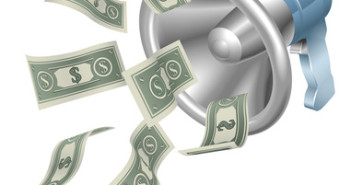The Fed surprised with a hawkish view on employment, acknowledging the “solid gains”. We all know that, and it’s nice that the Fed finally sees it as well. But the one important thing missing from jobs reports was a gain in wages: people are getting back to work but wages remain depressed, weighing on the overall economy. But, for a change, the Fed was not worried about inflation.
Is the Fed seeing wage hikes around the corner? If we look back at history, there is a good reason to believe so.
Update: Are US salary raises around the corner? More evidence for a rate hike in March
Unemployment and wage
Ana Gil at Bond Vigilantes asked back in September if wage are at the tipping point and mentions an interesting fact:
A look into 30 years’ worth of US labour market data reveals an interesting relationship between headline unemployment and wages, measured by hourly earnings of all employees on private nonfarm payrolls. As is shown in the chart below, wages seem to have historically accelerated whenever the US unemployment rate has touched, or come close to, a 6% level. History may not repeat itself, but it could well rhyme.
Now, as we know, the low unemployment rate, currently at 5.9%, is also a result of a low participation rate: 62.7%, the lowest since 1978. So, in order to see history rhyme, we would either need an even lower unemployment rate, or another drop in “real unemployment rate”, U-6 is at 11.8%.
Let’s take another look at the asked back in September, which takes another look at history:
Back in 1994, when the Fed had just started a series of aggressive rate hikes, US wage growth was only 2.4% YoY. Today, wage growth is 2.5%. Yet, Fed speakers have argued some slack remains in the labour market, hence the need to maintain a very patient policy stance – but could the prospect of rising wages in an economy rapidly approaching full employment be the tipping point that prompts the Fed to change rhetoric?
Indeed, the time is not ripe for an interest hike just yet, but the change in rhetoric certainly came along in the October meeting.
The current trend in job gains has been solid and steady. It’s not only NFP and the unemployment rate, but also the best JOLTs number since 2001 and the lowest jobless claims since 2000. If current trends continue, wage hikes could certainly be around the corner, and so could a rate hike.
A raise in salaries?
But already now, are wage hikes that slow? According to a recent survey by ADP, wages are rising faster than officially measured.
In addition, it is important to note that workers gain a salary raise when they switch jobs more often than when they stay at the same job. But, most people stay in the same job for long periods. And when do they get a raise in the current jobs? Usually around year end.
We could certainly see a bump up in wages in the official data coming at the Non-Farm Payrolls report in January and February. On such a scenario, the Fed would already be behind the curve, and would have to act sooner rather than later.
In March, the Fed decision is accompanied by a press conference.
Can we expect a March 2015 rate hike in the US?
